Realism: Honoré Daumier |
Realism: Honoré Daumier |
|
Honoré Daumier (1808-79) lived in Paris during troubled political times (the revolutions of 1830 and 1848) and during a time of rapid industrialization and much social unrest. He was a painter, sculptor, and graphic artist who was even temporarily imprisoned because of his social protest and criticism of the government. His criticism largely took the form of satirical lithographs (more than 4000 in his career) published in leading liberal journals. His style is often exaggerated, or caricature (thus not totally realistic), but he always depicts the real, factual, contemporary world. Characteristically, he sympathized with the poor and urban working class and lampooned the behavior of politicians, lawyers, the wealthy. | |
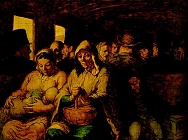 |
The Third-Class Carriage, c. 1862 This painting illustrates Daumier's sympathy with the urban poor, who can only afford the cheapest tickets for this horse-drawn carriage. Still, the grandmother, daughter, and two children are united in a pyramid while the separation of the richer passengers behind them may indicate urban alienation. |
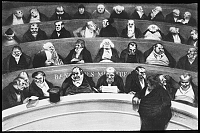 |
The Legislative Paunch, lithograph, 1834Here Daumier lampoons the behavior of politicians, some of whom gossip, one of whom blows his nose, and others sleep. |
| The criminal justice system also came under the attack of Daumier's lithographic crayon. Below he depicts snooty lawyers (left) and a lawyer who refuses to listen to the case of a poor man. | |
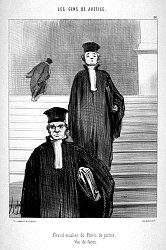 |
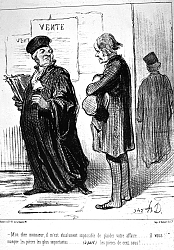 |
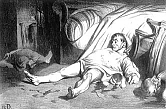 |
Rue Transnonain, 1834 |
Throughout Daumier's career he recorded his anti-war sentiments, often with the pragmatic argument that war was expensive and the arms race counterproductive. Left: "Disarmament--after you"; center: "The European balance of Power"; right: "The return of Peace in 1871 will find France devastated" | |
All images marked MAS were photographed on location by Mary Ann Sullivan. All other images were scanned from other sources or downloaded from the World Wide Web; they are posted on this password-protected site for educational purposes, at Bluffton College only, under the "fair use" clause of U.S. copyright law.